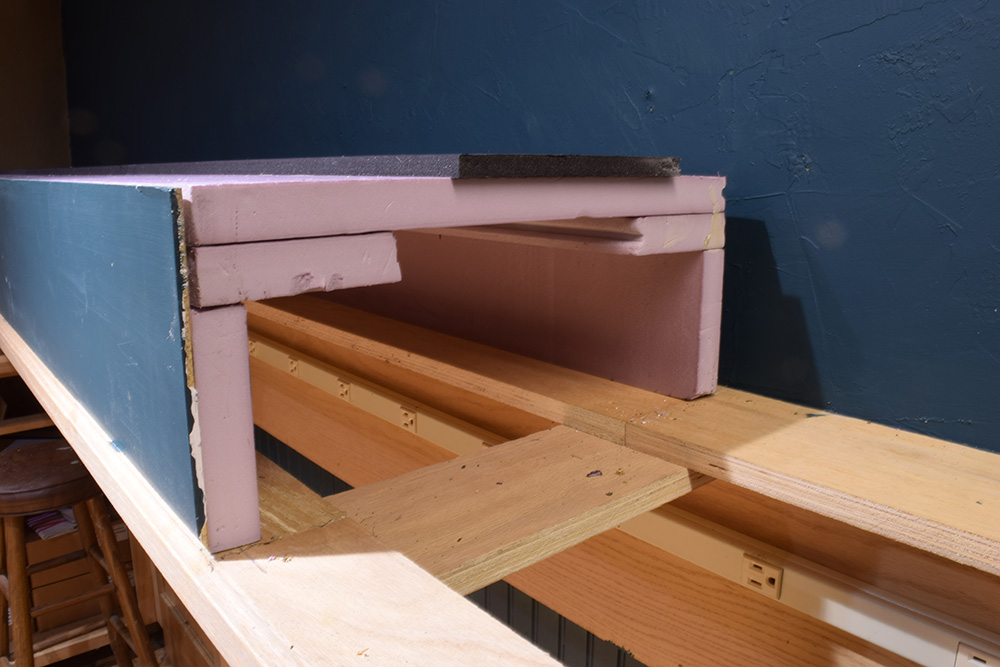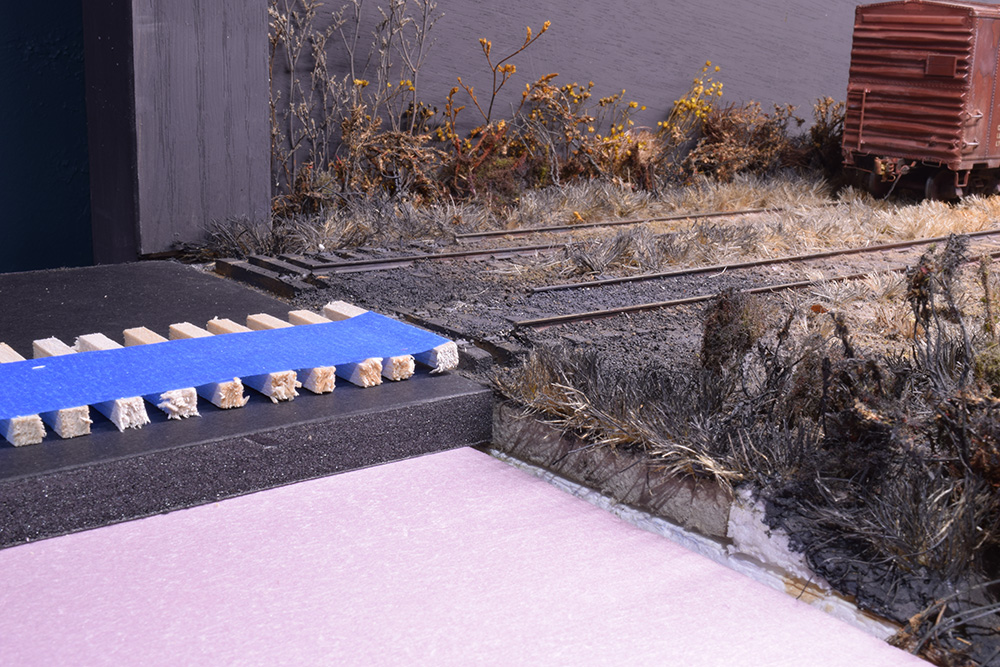Scatterbrained would be a generous term for my working methods. I’ve seldom been one to design on paper, preferring instead to play around with a bunch of materials until something clicks.
I try things, believing I’ve found a solution only to realize halfway through there is a simpler more elegant approach. Of course, I’ll rip out the previous work and go with the new method. It’s cumbersome, often wasteful, but somehow it works for me.
This new project has undergone several changes in both concept and format. As a result, the design of the foam sections has changed too.
I’m using the same support structure and have decided to incorporate the Mill Road cameo back into the design. Two reasons for this are: 1) It’s complete and has built-in lighting, and 2) It’s a shame to let it sit idle.
I removed the aluminum sheeting used for the sky and am going with a plain black/charcoal background across the entire scene. The extreme contrast of that bright background was the stumbling block I couldn’t resolve in prior attempts to redesign this scene. Without it, the character of the cameo blends more easily with any new additions on either end. I’m satisfied this was a good decision.
Foam is Easy To Modify
Reusing Mill Road meant I had to modify the foam section I already built. This was a simple matter of adding two vertical support pieces to bring the track surface even with Mill Road. At the front I added a strip of quarter-inch plywood to match the fascia across both sections. For the new construction, this is the only wood used. Everything else is made from foam board including the sub roadbed. (See this post for more details.)
Thus far I like where this is going. The foam is lightweight, easy to work and seems more than adequate structurally. Whether it holds up over an extended length of time is of little concern to me. We build these things as if they will last for a century, when, in truth, we all know better. More than anything, at this stage in my life, I want a craft that is simple, elegant and easy to live with.
Regards,
Mike

(Above) The cross section of this module is straightforward in design. It was originally meant to sit on a shelf, with a wiring chase created by the two horizontal strips of foam glued under the top piece. When I decided to reuse the Mill Road cameo, I added the lower vertical pieces to bring the track surface to the same level (Image below). The thin plywood fascia panel is for durability at this vulnerable edge and is the only wood used in the construction. It will be repainted to match the fascia on Mill Road.

(Above.) The foam core roadbed should be fine based on previous experiments with the material. It eliminates a major source of needless weight from the homasote or fiberboard commonly used.
In the final image below, the nondescript background looks messy in this photo but doesn’t draw the eye away from the modeling when seen in person. (That’s my story and I’m sticking with it.)

Good morning,
Not just the eye but the camera: how they react to the contrast of the black backdrop and the contrast with the modelled scene. It’s a fascinating idea.
You open with a comment about “scatterbrained” working methods but instead this reads like a sculptural exploration. There’s a lot to be said for working with our hands right in the clay. I love sketching so use it often and it features heavily in my experience but it does so because that’s what I like. We tend to see everything as a component or process step subservient to the whole of making a model railway. I’m discovering that I have a hobby of model trains but I also have a hobby of sketching subjects that are model train-related and they’re equal, but different ways to work with model railway-ing. In a way, this also distinguishes ideas about how we work in the media of making the models, perhaps even freeing us to “dive right in” to just making the thing.
I love the idea of exploring a creative reuse of Mill Road. We tend to practice an additive method where changes to a layout are only minor, not full iterations of change. When we’re creating the layout we are driving it toward a vision of its finished state but, once complete, can we see it as a starting point to be incorporated into a new venture? A layout like a wonderful roast turkey that is at first a delicious meal but whose leftovers become a equally beautiful soup later in the week.
I won’t ask “what’s next” and I sure am keen to learn more about what you explore, with this, next and where your imagination carries you.
Chris
Chris,
I agree we all have different working methods. My iterative approach works for me while it would drive another crazy. I also agree that we often start from scratch with a redesign rather than consider ways to incorporate prior work. In my view this reflects the way we are taught to copy (a location, building, freight car, each other) rather than design and create. As for what’s next, I’ve no idea really. -Mike